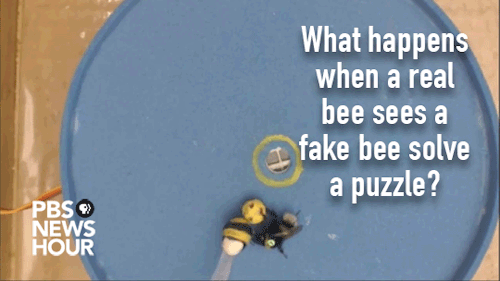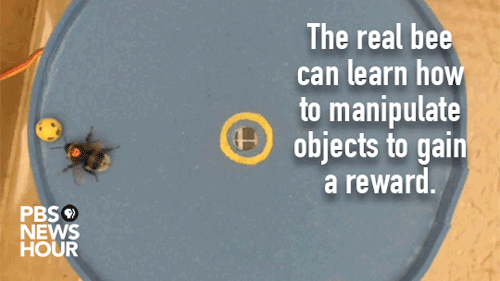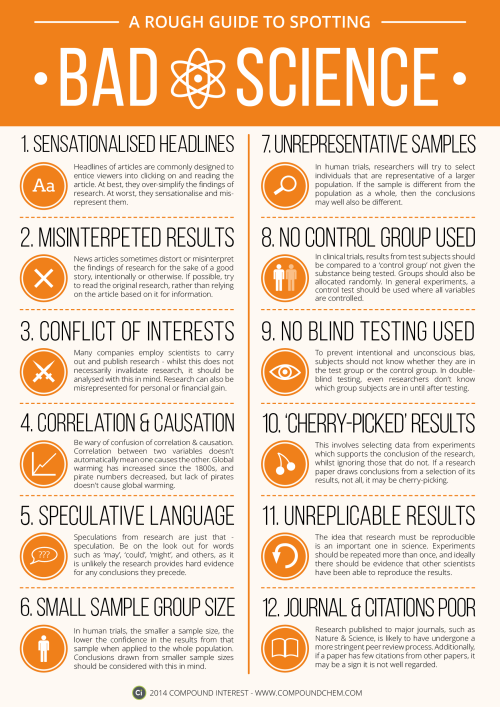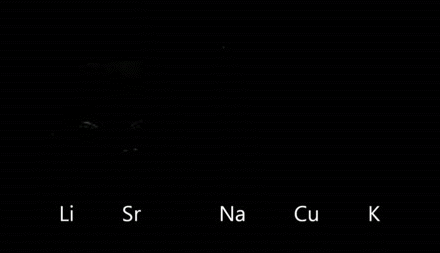What Does It Take To Teach A Bee To Use Tools? A Little Time, A Good Teacher And An Enticing Incentive.


What does it take to teach a bee to use tools? A little time, a good teacher and an enticing incentive. Read more here: http://to.pbs.org/2mpRUAz
Credit: O.J. Loukola et al., Science (2017)
More Posts from Science-is-magical and Others

Version 1 of ‘A Rough Guide to Spotting Bad Science’. Thanks for everyone’s suggestions earlier in the week, attempted to include as many of them as possible!
Download link here: http://wp.me/p4aPLT-ap

In chemistry, flame tests are used to detect the presence of certain elements, primarily metal ions, by analyzing the colour of the flame given off when heated.
above are Lithium (Li), Strontium (Sr), Sodium (Na), Copper(Cu), and Potassium (K).

It turns out that there’s actually a scientific reason behind why people don’t sleep soundly in an unfamiliar place.
According to a study conducted by Brown University, the first night that you sleep in a new environment the left hemisphere of the brain stays alert while the right hemisphere rests. The biological trait is thought to have allowed early humans to respond to nighttime threats. “When we’re sleeping in a new environment and we don’t know how many predators are around, it would make sense to keep half the brain more alert and more responsive to bumps in the night,” said Niels Rattenborg, who led the study.
The evolutionary advantage this brain traits provides is probably less useful to modern humans — making us experience less restful sleep when we spend the night at a hotel or friend’s house, for example — but in the animal kingdom, this trait still helps marine mammals such as dolphins, whales, and seals respond to threats during their slumber.
Today is Copernicus’s 540th birthday. You may remember Copernicus as the man who said “Hey, what if the Earth went around the sun?” To which the Catholic Church replied “Hey, what if we set you on fire?”
New technique captures the activity of an entire brain in a snapshot
When it comes to measuring brain activity, scientists have tools that can take a precise look at a small slice of the brain (less than one cubic millimeter), or a blurred look at a larger area. Now, researchers at The Rockefeller University have described a new technique that combines the best of both worlds—it captures a detailed snapshot of global activity in the mouse brain.

(Image caption: Sniff, sniff: This density map of the cerebral cortex of a mouse shows which neurons get activated when the animal explores a new environment. The lit up region at the center (white and yellow) represents neurons associated with the mouse’s whiskers)
“We wanted to develop a technique that would show you the level of activity at the precision of a single neuron, but at the scale of the whole brain,” says study author Nicolas Renier, a postdoctoral fellow in the lab of Marc Tessier-Lavigne, Carson Family Professor and head of the Laboratory of Brain Development and Repair, and president of Rockefeller University.
The new method, described in Cell, takes a picture of all the active neurons in the brain at a specific time. The mouse brain contains dozens of millions of neurons, and a typical image depicts the activity of approximately one million neurons, says Tessier-Lavigne. “The purpose of the technique is to accelerate our understanding of how the brain works.”
Making brains transparent
“Because of the nature of our technique, we cannot visualize live brain activity over time—we only see neurons that are active at the specific time we took the snapshot,” says Eliza Adams, a graduate student in Tessier-Lavigne’s lab and co-author of the study. “But what we gain in this trade-off is a comprehensive view of most neurons in the brain, and the ability to compare these active neuronal populations between snapshots in a robust and unbiased manner.”
Here’s how the tool works: The researchers expose a mouse to a situation that would provoke altered brain activity—such as taking an anti-psychotic drug, brushing whiskers against an object while exploring, and parenting a pup—then make the measurement after a pause. The pause is important, explains Renier, because the technique measures neuron activity indirectly, via the translation of neuronal genes into proteins, which takes about 30 minutes to occur.
The researchers then treat the brain to make it transparent—following an improved version of a protocol called iDISCO, developed by Zhuhao Wu, a postdoctoral associate in the Tessier-Lavigne lab—and visualize it using light-sheet microscopy, which takes the snapshot of all active neurons in 3-D.
To determine where an active neuron is located within the brain, Christoph Kirst, a fellow in Rockefeller’s Center for Studies in Physics and Biology, developed software to detect the active neurons and to automatically map the snapshot to a 3-D atlas of the mouse brain, generated by the Allen Brain Institute.
Although each snapshot of brain activity typically includes about one million active neurons, researchers can sift through that mass of data relatively quickly if they compare one snapshot to another snapshot, says Renier. By eliminating the neurons that are active in both images, researchers are left only those specific to each one, enabling them to home in on what is unique to each state.
Observing and testing how the brain works
The primary purpose of the tool, he adds, is to help researchers generate hypotheses about how the brain functions that then can be tested in other experiments. For instance, using their new techniques, the researchers, in collaboration with Catherine Dulac and other scientists at Harvard University, observed that when an adult mouse encounters a pup, a region of its brain known to be active during parenting—called the medial pre-optic nucleus, or MPO—lights up. But they also observed that, after the MPO area becomes activated, there is less activity in the cortical amygdala, an area that processes aversive responses, which they found to be directly connected to the MPO “parenting region.”
“Our hypothesis,” says Renier, “is that parenting neurons put the brake on activity in the fear region, which may suppress aversive responses the mice may have towards pups.” Indeed, mice that are being aggressive to pups tend to show more activity in the cortical amygdala.
To test this idea, the next step is to block the activity of this brain region to see if this reduces aggression in the mice, says Renier.
The technique also has broader implications than simply looking at what areas of the mouse brain are active in different situations, he adds. It could be used to map brain activity in response to any biological change, such as the spread of a drug or disease, or even to explore how the brain makes decisions. “You can use the same strategy to map anything you want in the mouse brain,” says Renier.
The Brain Can Reveal Drinking Status Even After Death
Scientists who use postmortem brain tissue to study alcohol’s effects on brain structure and function will find this research interesting. Phosphatidylethanol (PEth) is an alcohol metabolite and its concentration in whole blood samples is a biomarker of drinking habits. For this study, scientists examined PEth levels in postmortem brains of individuals known to have had alcohol use disorders (AUDs).
Researchers divided 30 postmortem brains into three groups: 10 with AUDs that had positive serum alcohol levels present at the time of autopsy; 10 with AUDs that did not show positive serum alcohol levels at the time of autopsy; and 10 normal brains. PEth levels were measured in the cerebellum and orbital frontal cortex (OFC) regions.
Results showed that PEth was present in the cerebellum and OFC of all brains in all three groups of subjects, including the controls. The AUD group with detectable serum alcohol levels at the time of autopsy had much higher levels of PEth in both brain areas than either the control group or the AUD group whose subjects did not have detectable serum ethanol at autopsy. Thus, the ability to measure PEth levels in postmortem human brains can be helpful in classifying drinking status in individuals with AUDs at the time of death.

Machine Learning: An In-Depth, Non-Technical Guide
A good introductory text in five parts:
Overview, goals, learning types, and algorithms
Data selection, preparation, and modeling
Model evaluation, validation, complexity, and improvement
Model performance and error analysis
Unsupervised learning, related fields, and machine learning in practice
By Alex Castrounis - {InnoArchiTech}
-
 reixulian reblogged this · 1 week ago
reixulian reblogged this · 1 week ago -
 reixulian liked this · 1 week ago
reixulian liked this · 1 week ago -
 mrkiwiz46 reblogged this · 1 week ago
mrkiwiz46 reblogged this · 1 week ago -
 durinsbride reblogged this · 1 week ago
durinsbride reblogged this · 1 week ago -
 fandom-hoarder reblogged this · 1 week ago
fandom-hoarder reblogged this · 1 week ago -
 thehorseofadifferentcolour reblogged this · 1 week ago
thehorseofadifferentcolour reblogged this · 1 week ago -
 fading-bisexual-queen-milkshake reblogged this · 2 weeks ago
fading-bisexual-queen-milkshake reblogged this · 2 weeks ago -
 naganna418 liked this · 3 weeks ago
naganna418 liked this · 3 weeks ago -
 pheonixqueen reblogged this · 3 weeks ago
pheonixqueen reblogged this · 3 weeks ago -
 pheonixqueen liked this · 3 weeks ago
pheonixqueen liked this · 3 weeks ago -
 fox-mulder-666 reblogged this · 4 weeks ago
fox-mulder-666 reblogged this · 4 weeks ago -
 kirbo-kirbstar liked this · 1 month ago
kirbo-kirbstar liked this · 1 month ago -
 lmaojune reblogged this · 1 month ago
lmaojune reblogged this · 1 month ago -
 catsarecoolstudios reblogged this · 1 month ago
catsarecoolstudios reblogged this · 1 month ago -
 autistic-morpheus liked this · 1 month ago
autistic-morpheus liked this · 1 month ago -
 meieuys liked this · 1 month ago
meieuys liked this · 1 month ago -
 the-bellfrost-incident reblogged this · 1 month ago
the-bellfrost-incident reblogged this · 1 month ago -
 sensationaltrainreading reblogged this · 1 month ago
sensationaltrainreading reblogged this · 1 month ago -
 arsenichoneypuff liked this · 1 month ago
arsenichoneypuff liked this · 1 month ago -
 almost-correct-quotes liked this · 1 month ago
almost-correct-quotes liked this · 1 month ago -
 realmagpiehours reblogged this · 1 month ago
realmagpiehours reblogged this · 1 month ago -
 realmagpiehours liked this · 1 month ago
realmagpiehours liked this · 1 month ago -
 starlight-in-a-bottle reblogged this · 1 month ago
starlight-in-a-bottle reblogged this · 1 month ago -
 adelth liked this · 1 month ago
adelth liked this · 1 month ago -
 crowlame-and-azirafail reblogged this · 1 month ago
crowlame-and-azirafail reblogged this · 1 month ago -
 thewitchiestdoctor liked this · 1 month ago
thewitchiestdoctor liked this · 1 month ago -
 wreckerradioactive reblogged this · 2 months ago
wreckerradioactive reblogged this · 2 months ago -
 monstrumzirkus reblogged this · 2 months ago
monstrumzirkus reblogged this · 2 months ago -
 a-friend-of-mara liked this · 2 months ago
a-friend-of-mara liked this · 2 months ago -
 pretty-pink-seaslug reblogged this · 2 months ago
pretty-pink-seaslug reblogged this · 2 months ago -
 timatisblog reblogged this · 2 months ago
timatisblog reblogged this · 2 months ago -
 namelessokami reblogged this · 2 months ago
namelessokami reblogged this · 2 months ago -
 fallen-starr liked this · 2 months ago
fallen-starr liked this · 2 months ago -
 dragononymous liked this · 2 months ago
dragononymous liked this · 2 months ago -
 satsuj1n liked this · 2 months ago
satsuj1n liked this · 2 months ago -
 gamergirl-lumine liked this · 3 months ago
gamergirl-lumine liked this · 3 months ago -
 brightclaws5tudios reblogged this · 3 months ago
brightclaws5tudios reblogged this · 3 months ago -
 brightclaws5tudios liked this · 3 months ago
brightclaws5tudios liked this · 3 months ago -
 lazyassryan reblogged this · 3 months ago
lazyassryan reblogged this · 3 months ago -
 lazyassryan liked this · 3 months ago
lazyassryan liked this · 3 months ago -
 pileofrocksjh reblogged this · 3 months ago
pileofrocksjh reblogged this · 3 months ago -
 pileofrocksjh liked this · 3 months ago
pileofrocksjh liked this · 3 months ago -
 awkwardnoob reblogged this · 3 months ago
awkwardnoob reblogged this · 3 months ago -
 roseycanvas reblogged this · 3 months ago
roseycanvas reblogged this · 3 months ago -
 lucadrawss reblogged this · 3 months ago
lucadrawss reblogged this · 3 months ago -
 intothefandomverse liked this · 3 months ago
intothefandomverse liked this · 3 months ago -
 emmajanereading reblogged this · 3 months ago
emmajanereading reblogged this · 3 months ago -
 aedifica liked this · 3 months ago
aedifica liked this · 3 months ago

